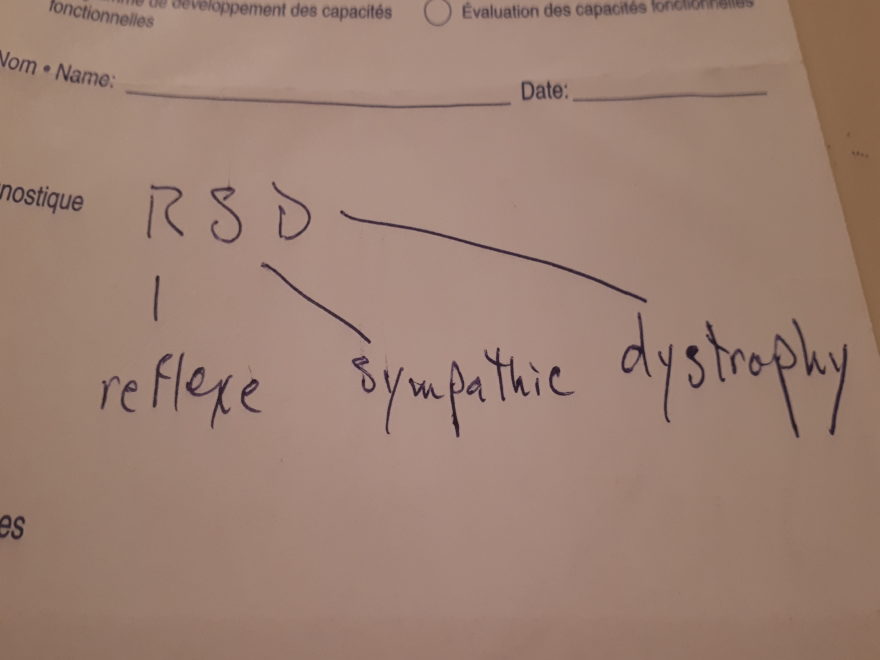November is the annual awareness month for Complex Regional Pain Syndrome, or CRPS. We’re halfway through the month, so I thought this would be a good opportunity to dispel some of the confusion surrounding this rare disease.
There is confusion about this medical condition on many levels, including; what it’s called, what it is, how to test for (or diagnose) it, how to treat it, how to live with it…
Let’s start with the easiest of these, the first point of confusion commonly encountered with CRPS; what it’s called. The official name of this disease is decided by a worldwide medical organization; the International Association for the Study of Pain (IASP).
In 1994 the IASP changed the name of Reflex Sympathetic Dystrophy (RSD) to CRPS.(1) As you can imagine, this caused a great deal of confusion among nurses, physicians, occupational and physical therapists, researchers, and all the rest of the healthcare establishment. It must also have wreaked havoc on the health insurance industry…
Some of that confusion remains, to this day. I’ve have first-hand experience of this, in my own patient journey. My first tentative diagnosis of CRPS was provided by a specialist physician, after I’d spent almost three months trying to convince him that there really was something wrong with me.
What did that specialist write onto a slip of paper, while telling me to ‘Google this’? He wrote out the old name of the disease, which he misspelled as ‘reflexe sympathic dystrophy’.
It’s ironic, that with all the jokes about physicians’ horrid handwriting, this one had perfectly legible handwriting; but he couldn’t even spell the outdated name of a medical condition!
He added an ‘e’ to reflex, and replaced ‘…pathetic’ in the word ‘sympathetic’ with ‘pathic’. Which really is kind of ‘pathetic’, isn’t it?
The former name of CRPS still features prominently in the name of its Canadian patient organization, likely due the expense that would be involved in a change of the legal name for such a small charitable organization:
P.A.R.C. Promoting Awareness of RSD/CRPS in Canada is an organization whose mission is to support, educate and inform people affected by reflex sympathetic dystrophy (RSD), otherwise known as complex regional pain syndrome (CRPS).”(2)
CRPS has also been known through the years as algodystrophy, causalgia, Sudek’s atrophy, sympathetic neuritis, and traumatic arterial vasospasm.(3) And these are only the other names that I know about; there may be others!
There are only few diseases that have such a controversial history as the Complex Regional Pain Syndrome (CRPS).
Even its denomination underwent several changes to emphasize the prevalent pathogenic beliefs developed through the history of medicine.”(3)
The word denomination, in that quote, means the current name of the disease. The term pathogenic beliefs, in this specific medical journal article, refers to what physicians and researchers thought the causes of the disease to be – at any given time.
This is because the previous names of CRPS were meant to describe what some physicians believed to be the cause of the condition. For example two of the old names for CRPS, algodystrophy and Reflex Sympathetic Dystrophy, incorporated the word dystrophy.
At those times, it was widely believed by the medical establishment that the symptoms of the disease were caused in some way by a degeneration of tissue; a dystrophy of some sort.
Hopefully we’ve now laid to rest the confusion surrounding the name of CRPS! Tomorrow I’ll broach another topic of confusion; what it is. Drop by tomorrow, and in the meantime keep an eye out for most posts over on Instagram and Twitter.
Thanks so much for reading, and feel free to drop me a line on either of those two social media. There’s no comment box on this blog anymore, because it was being bombarded with obscene images – apparently from Chinese and Russian sources.
Have a great day! If you’re also in the Montreal area, be careful out there; winter seems to have arrived early, and the roads and sidewalks are already very icy. I really mean that – be careful! Falling on an invisible patch of winter ice is how I fractured my arm, and that was the injury that triggered my CRPS.
References:
(1) International Association for the Study of Pain (IASP). Classification of Chronic Pain, Second Edition (Revised). Section Ai Relatively Generalized Syndromes. 2012 update. Online. Accessed 07 Nov 2019. Web:
https://www.iasp-pain.org/PublicationsNews/Content.aspx?ItemNumber=1673
(2) National Organization for Rare Disorders (NORD): Find a Patient Organization. P.A.R.C. Promoting Awareness of RSD/CRPS in Canada. Accessed 07 Nov 2019. Web:
https://rarediseases.org/organizations/p-a-r-c-promoting-awareness-of-rsdcrps-in-canada/
(3) Iolascon G, de Sire A, Moretti A, Gimigliano F. Complex regional pain syndrome (CRPS) type I: historical perspective and critical issues. Clin Cases Miner Bone Metab. 2015;12(Suppl 1):4–10. Online 07 Apr 2016. doi:10.11138/ccmbm/2015.12.3s.004. Accessed 07 Nov 2019. Web:
https://www.ncbi.nlm.nih.gov/pmc/articles/PMC4832406/

